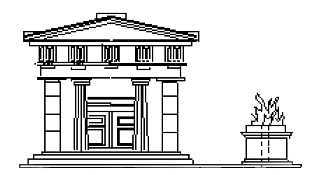| Hypercommunication - Crash Courses - Second-order Systems Theory [ Hyper-Library ] [ Hyper-Lexicon ] [ back ] |
|
|
backward - Page 13 - forward |
|
Explanations I call descriptions of procedures that I can use to generate the phenomena I want to explain (). (Note 1). With an explanation I cannot open the door, I have to use the procedure described in the explanation to make the door open. Recipes are typical descriptions of procedures. They are usually not read as explanations but as instructions, but they explain how the described food comes about. However, I do not eat the recipe, but the food (note 2).
|

A possible explanation from Heron of Alexandria |
There are any number of explanations for each phenomenon, whereby different explanations determine the phenomenon in different ways, quasi retroactively (note 3). I could explain the phenomenon with the temple door with the fact that the priest hypnotizes the audience so that they imagine that the doors open. Since in this case the doors do not open at all, there is of course no need to explain that they do open. What is needed is an explanation of why I see things that do not exist. And that would be explained by "hypnosis" (see note 1), but of course the phenomenon is also seen in a completely new way. I can also describe how I myself must function in order to perceive a certain phenomenon at all. I will write more about this later. Now I want to give explanations that the doors really open when the priest lights the fire on the altar.
For example, an explanation may state that the gods must be invoked by ritualistic calling: "Call abracadabra and look carefully at the door that is to open! When the gods hear you, they will open the door." It works for the priests because the gods answer them. This explanation, like any explanation, has some implications, such as that there are gods. If there are gods that help the priests, that's one possible explanation. Otherwise not. Whether I accept an explanation depends on me (note 4).
Another possible explanation for the temple doors opening would be that hidden slaves open the doors. This would presuppose that there are slaves in the temple and that you can describe what they are doing and why you cannot see them. Since I cannot see the slaves, it depends also with this explanation on me whether I accept it.
Finally, there are constructive explanations that explain the phenomenon - such as Heron von Alexandria - by underground machines.
|
Examine the explanation you gave on the previous page! |
It is not a question of the correctness of the declaration, but whether the declaration really describes procedures that, if realized, would open and close the doors. |
|
Think about how the different explanations differ ! |
And ask yourself which explanations you like best and why. |
|
Examples:
|
Very often there are different procedures that lead to a certain goal, and in most cases they can be described on different levels and with different degrees of explicitness. The present system theory - nomen est omen - uses constructive explanation.
"A Constructivist social theory elaborates... constructs (models, systems) that explain our (as)perceptions of social phenomena by the fact that the components of the models/systems produce the phenomena chosen as a problem through their interactions' (Hejl)" (S. Schmidt: 50).
|
|
backward - Page 13 - forward |